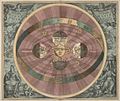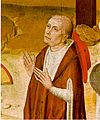Heliocentrism facts for kids
Heliocentrism (pronounced hee-lee-oh-SEN-trizm) is a model of the solar system where the Sun is at the center. The word "heliocentric" comes from the Greek words "helios," meaning "Sun," and "kentron," meaning "center." So, heliocentric literally means "Sun-centered." In this model, Earth and the other planets all travel around the Sun in paths called orbits.
Contents
A big change in thinking
For a very long time, people believed something different. They thought Earth was the center of everything, and the Sun, Moon, and stars all circled around us. This idea is called geocentrism (jee-oh-SEN-trizm), where "geo" means "Earth." It seemed to make sense because when you stand on Earth, it feels like you're not moving, and everything else is going around you.
How did heliocentrism come about?
The idea of heliocentrism didn't just pop up overnight. It took many smart people, lots of observations, and a long time to convince everyone that the Sun was the center.
Ancient ideas
Some people in ancient Greece had an idea that the Earth might be moving around the Sun. One of the first was Aristarchus of Samos, who lived a long, long time ago. He even figured out that the Sun was much bigger than the Earth! But most people still believed in geocentrism.
Nicolaus Copernicus
A Polish astronomer named Nicolaus Copernicus, who lived from 1473 to 1543, is famous for bringing back the heliocentric idea. He studied the movements of the planets and realized that it made much more sense if the Sun was at the center. In 1543, Copernicus published a book called "De revolutionibus orbium coelestium" ("On the Revolutions of the Heavenly Spheres"). In this book, he explained his heliocentric theory in detail.
Important points of Copernicus's theory
- The Sun is near the center of the universe.
- The planets, including Earth, travel around the Sun in a specific order: Mercury, Venus, Earth and Moon, Mars, Jupiter, and Saturn.
- The Earth spins on its axis every day, which is why we have day and night.
- The Earth also travels around the Sun once a year, which is why we have seasons.
- The stars are very, very far away.
Copernicus's idea was a big deal because it changed the way people thought about the universe and our place in it. It was the start of modern astronomy!
Other Important People
After Copernicus, other scientists helped to prove that heliocentrism was correct:
- Tycho Brahe (1546-1601): A Danish astronomer, made very detailed observations of the stars and planets. Although he didn't fully accept heliocentrism, his data was very important for other scientists.
- Johannes Kepler (1571-1630): A German astronomer, used Brahe's data to figure out that the planets don't travel in perfect circles around the Sun. Instead, they travel in ovals, called ellipses.
- Galileo Galilei (1564-1642): An Italian astronomer, built his own telescope and made many important discoveries that supported heliocentrism. For example, he saw that Venus goes through phases, just like the Moon, which could only happen if it was orbiting the Sun. He also discovered four moons orbiting Jupiter, proving that not everything orbits the Earth.
Evidence for Heliocentrism
Over time, scientists found lots of evidence that proves heliocentrism is correct:
- Phases of Venus: Galileo's observation that Venus goes through phases is strong evidence that it orbits the Sun.
- Moons of Jupiter: Galileo also discovered that Jupiter has its own moons, which showed that not everything orbits the Earth.
- Parallax: As the Earth moves around the Sun, the nearby stars seem to shift their position slightly against the background of more distant stars. This is called parallax, and it's another piece of evidence that the Earth is moving.
- Modern technology: Today, we have satellites and space probes that have traveled to other planets. They have sent back lots of pictures and data that confirm that the Sun is at the center of our solar system.
Images for kids
-
Aristarchus' 3rd century BC calculations on the relative sizes of the Earth, Sun and Moon, from a 10th-century AD Greek copy
-
An illustration from al-Biruni's astronomical works explains the different phases of the Moon with respect to the position of the Sun.
-
Nicholas of Cusa, 15th century, asked whether there was any reason to assert that any point was the center of the universe.
-
Portrait of Nicolaus Copernicus (1578)
See also
 In Spanish: Teoría heliocéntrica para niños
In Spanish: Teoría heliocéntrica para niños







